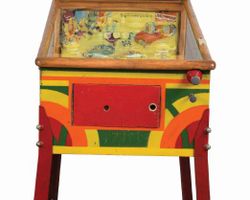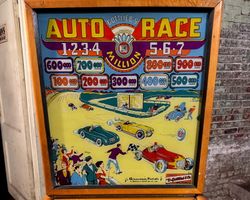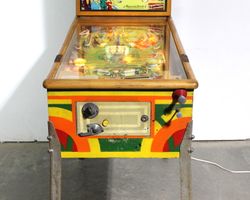Auto Race

Average Prices: USD $400 to $1,200
Produced: September, 1956
Production Run: 1,500 units
Machine Type: Electro-mechanical
Players: 1
Design by: Wayne Neyens
Art by: Roy Parker
Auto Race by Gottlieb, released in September 1956, emerges from a pivotal era in pinball history. This electro-mechanical (EM) machine, designated Model Number 118, was a product of D. Gottlieb & Co., a manufacturer deeply influential in shaping the industry’s early landscape. With a production run of 1,500 units, Auto Race tapped into the era’s fascination with speed and competition, translating the thrill of motor sports into a captivating one-player pinball experience.
The machine's design was orchestrated by Wayne Neyens, a designer known for his methodical approach to gameplay mechanics. His collaborations with artist Roy Parker often resulted in visually appealing and mechanically engaging titles. Parker's distinctive style is evident in Auto Race's playfield and backglass, which vibrantly depict the excitement of the racing theme. A unique aspect of the backglass, beyond Parker’s evocative art, is Gottlieb’s enduring slogan, "Amusement Pinballs, as American as Baseball and Hot Dogs!"—a phrase that underscored the company's identity and the game's cultural resonance. An intriguing production detail involves the machine’s electrical design: while the backglass was silkscreened with "Game Over" and a corresponding backbox insert had a light bulb hole, the wiring for a 'Game Over' relay was never implemented. This feature would not appear in Gottlieb's production line until seven machines later, with Royal Flush in 1957. Consequently, Auto Race's flippers remain energized even after the final ball has been played, a curious characteristic for collectors of early EM titles.
Signature Features and Design
Auto Race distinguishes itself through its harmonious blend of theme, artwork, and mechanical execution. The core racing concept is integrated directly into the gameplay through the visual representation of cars on the playfield, advanced by player interaction. Roy Parker's artistic contributions are central to the machine's appeal. The vibrant backglass and playfield artwork vividly portray classic racing imagery, from sleek vehicles to checkered flags, immediately immersing players in the competitive atmosphere.
Beyond the aesthetics, the machine's mechanical features are carefully orchestrated to support the racing narrative. The mechanism for "advancing cars" by hitting specific targets or rollovers directly translates the theme into a tangible gameplay objective. The inclusion of two distinct gobble holes, which alternate in their function to award specials, adds a layer of strategic depth. These elements, combined with the energetic action provided by four pop bumpers and two slingshots, create a dynamic playfield that constantly draws the player's attention. The design philosophy prioritized accessible yet challenging gameplay, where the player's skill directly influenced their progress through the "race."
Playfield and Mechanics
The playfield of Auto Race presents a clean, intuitive layout that belies its strategic depth. At its foundation are two flippers, positioned to offer precise control over ball trajectory. Above the flippers, two slingshots on either side provide dynamic rebound action, launching the ball back into the upper playfield. Four lively pop bumpers are strategically placed to maximize chaos and points, contributing to rapid ball movement. Two passive bumpers further up the playfield add to the rich tapestry of deflection points.
Central to the gameplay are three standup targets, arranged in a formation that encourages direct aiming. Hitting these targets, or specific rollovers integrated into the playfield, is the primary method for "advancing" the three conceptual cars displayed within the machine's scoring system. As these cars advance, they progress towards "completing races," a visible representation of player achievement. This progression directly influences the lighting of the machine's two gobble holes, which alternate between being lit for a "Special." The artwork across the playfield not only guides the eye but also reinforces the racing theme, with lanes and targets often framed by checkered patterns or racing motifs. The lighting, though rudimentary by modern standards, effectively communicates game state, particularly when a gobble hole is lit, drawing the player's focus to the critical shot needed to capitalize on their progress. The layout's design facilitates a flow that balances open areas for flipper control with dense areas of targets and bumpers, ensuring a consistent engagement for the player.
Gameplay Dynamics
The gameplay dynamics of Auto Race are built around a clear, progression-based objective that rewards both direct aiming and strategic play. The central goal revolves around "completing races" by hitting the three standup targets or triggering designated rollovers. Each successful hit contributes to advancing one of the three virtual cars, incrementally building towards a completed race. As races are completed, the two gobble holes on the playfield become alternately lit for a "Special."
This core mechanic forms the game's addictive loop. While lighting the Special is often achievable, even early in a game, the true challenge and allure lie in successfully directing the ball into the currently lit gobble hole. This often requires a precise shot from the flippers, transforming what seems like a simple objective into a test of skill under pressure. When a ball enters a lit gobble hole, it awards replays, with the number of replays increasing based on how many races the player has completed prior to the shot. A successful Special can yield up to nine replays, offering significant reward and extending gameplay. The maximum displayed point score for Auto Race is 7,990,000 points, providing a high score chase that complements the replay objective. This interplay between accumulating progress and then risking it on a crucial shot creates a compelling "come close" experience, where near misses drive players to continue. Strategies often involve carefully targeting the standup targets to advance cars, then shifting focus to accurate flipper control to convert the lit special.
Reception and Legacy
Auto Race has garnered a positive reception within the pinball community, consistently rated as a strong example of an early electro-mechanical machine. Reviewers frequently describe it as a well-rounded and engaging game, highlighting its "addictive" quality. Many players consider it an "enticing" experience that prompts repeated plays, often labeling it an "over-looked" or "under-rated" title from its era. For some long-time collectors, Auto Race has earned a place as a permanent fixture in their collections, a testament to its enduring appeal.
The machine's strengths are often cited as its beautiful artwork, cohesive theme, and straightforward yet challenging gameplay. The balance between the ease of lighting specials and the heightened difficulty of actually sinking the ball into the lit gobble hole is frequently praised as a key design element contributing to its addictiveness. This deliberate design choice exemplifies how early EM games could create profound engagement without complex rule sets. Auto Race stands as a quintessential 1956 Gottlieb woodrail, showcasing the design principles of Wayne Neyens and the artistic flair of Roy Parker. Its legacy lies not only in its enjoyable gameplay but also in its historical significance. The minor design quirk of the unimplemented "Game Over" relay offers a glimpse into the ongoing evolution of pinball features during this formative period. The machine's lasting reputation as a "great basic machine" that provides consistent, captivating play underscores its place as a robust and well-executed example of mid-1950s pinball engineering.
Sponsored Links
 Ebay Listings
Ebay Listings
 Auction Results
Auction Results
| Cost | Location | Date |
|---|---|---|
| USD $750 |  Maryland, United States Maryland, United States |
27 February, 2025 |
| USD $1,050 |  Ohio, United States Ohio, United States |
12 September, 2024 |
| USD $460 |  United States United States |
07 June, 2019 |
| USD $1,000 |  Nevada, United States Nevada, United States |
13 April, 2019 |
| USD $1,200 |  Washington, United States Washington, United States |
10 November, 2016 |
| USD $647 |  Pennsylvania, United States Pennsylvania, United States |
02 November, 2014 |
| USD $105 |  New Jersey, United States New Jersey, United States |
19 November, 2009 |


Private Policy · Search Website · Contact Us
As an eBay Partner, we may earn a commission from qualifying purchases made through links on this site, at no additional cost to you.
All trademarks and copyrighted materials remain property of their respective owners. All other content copyright 2007 - 2025 Pinpedia.



